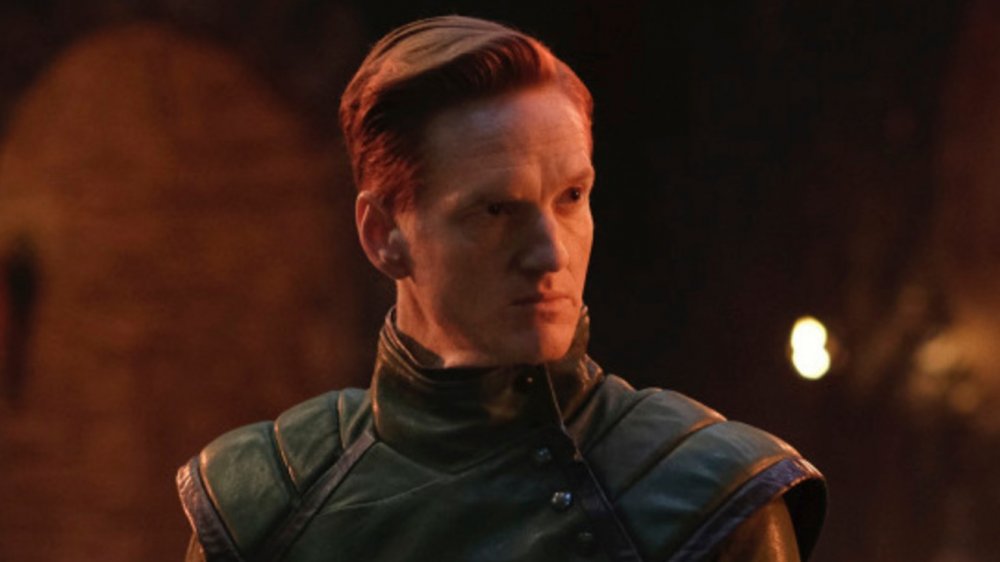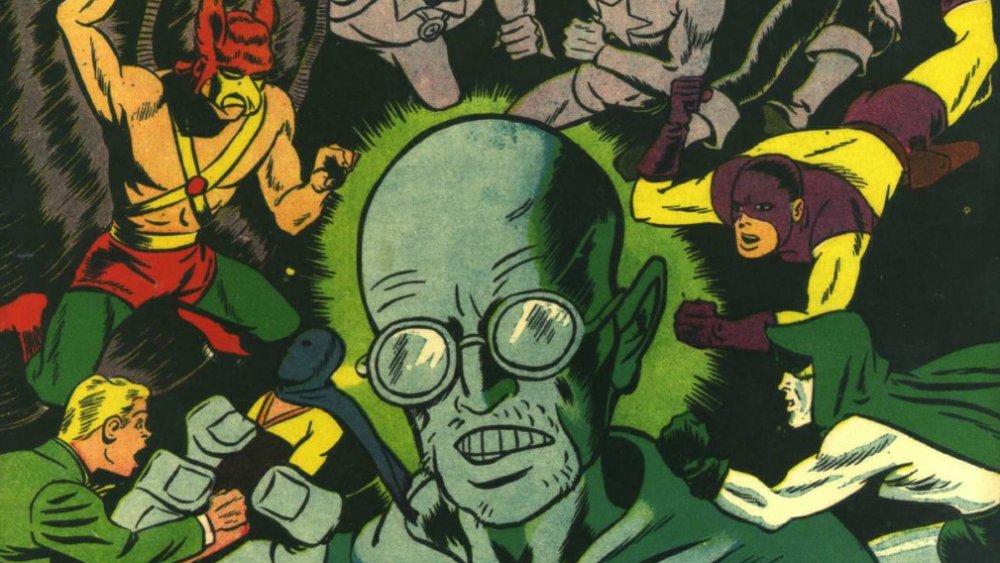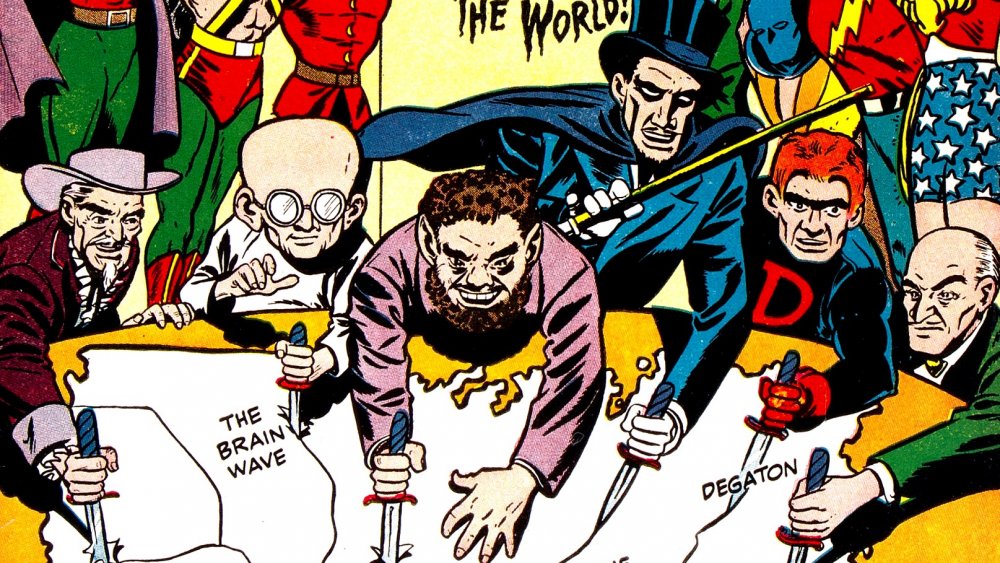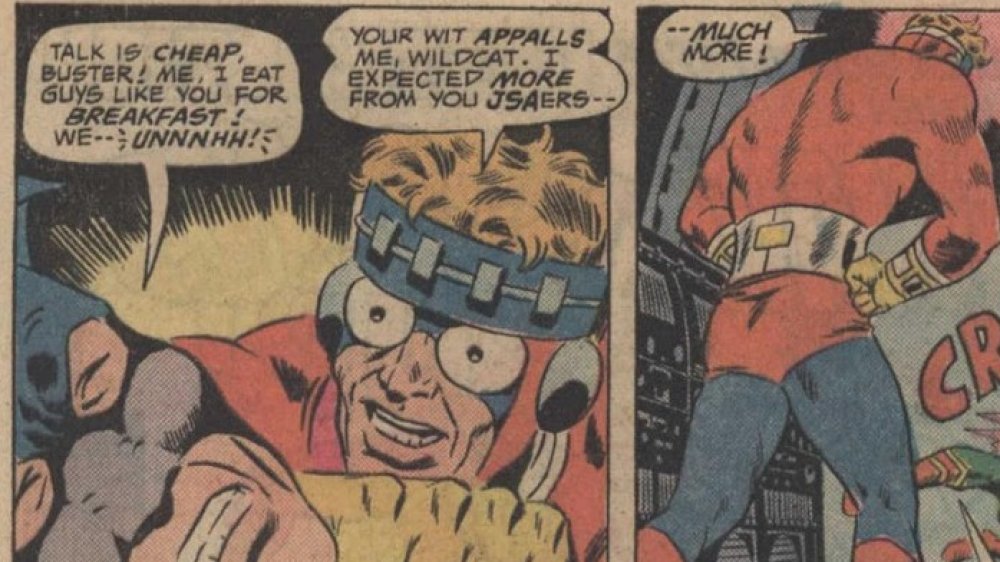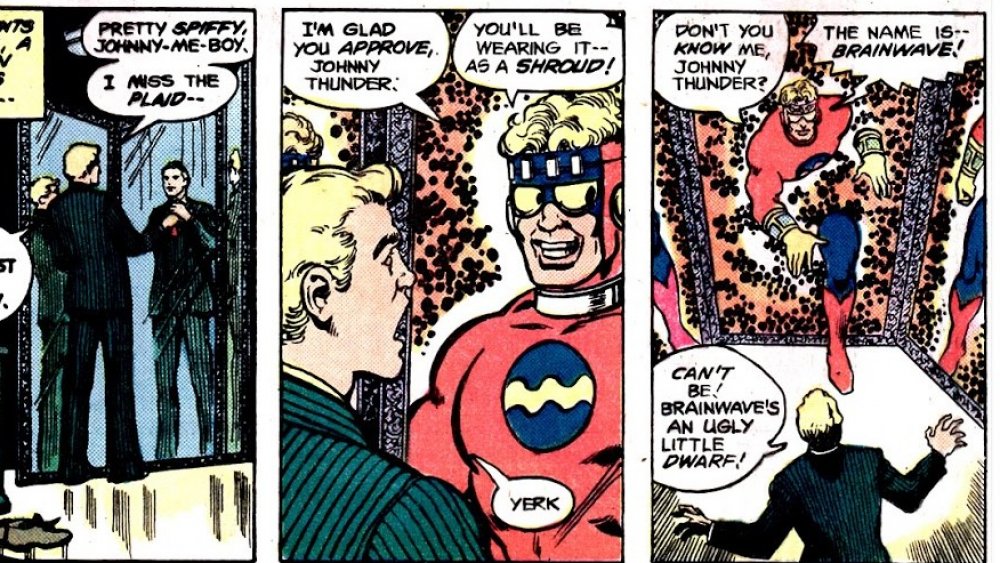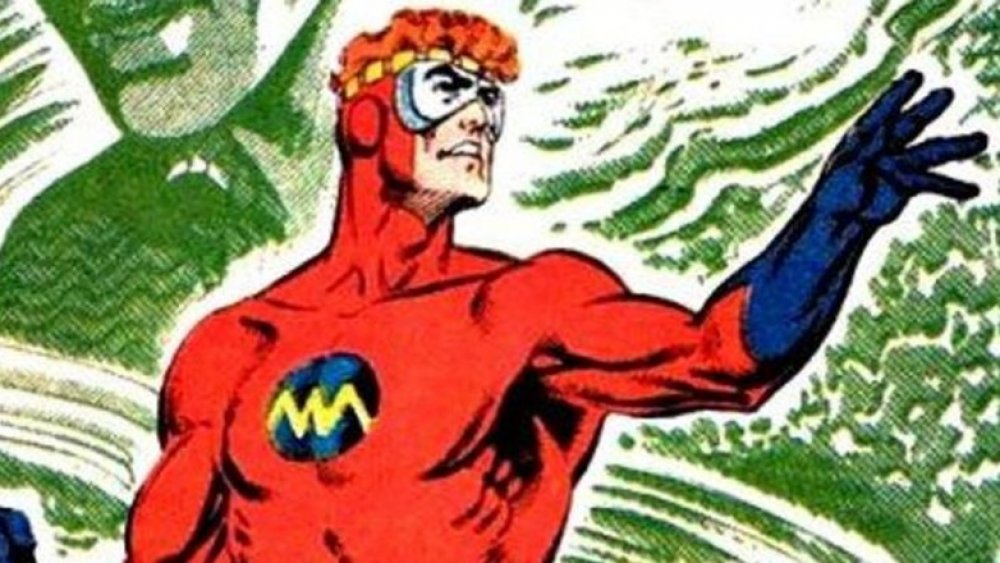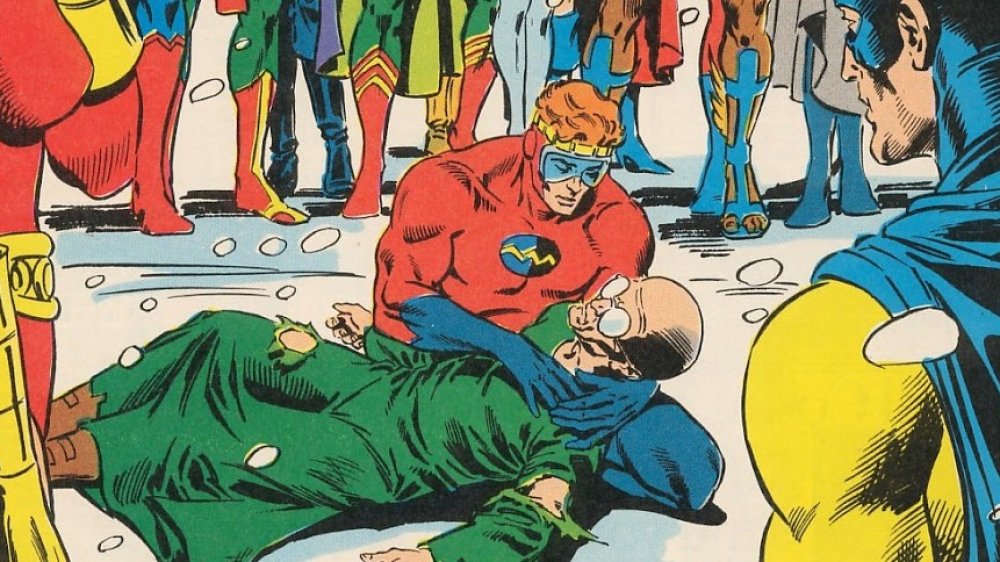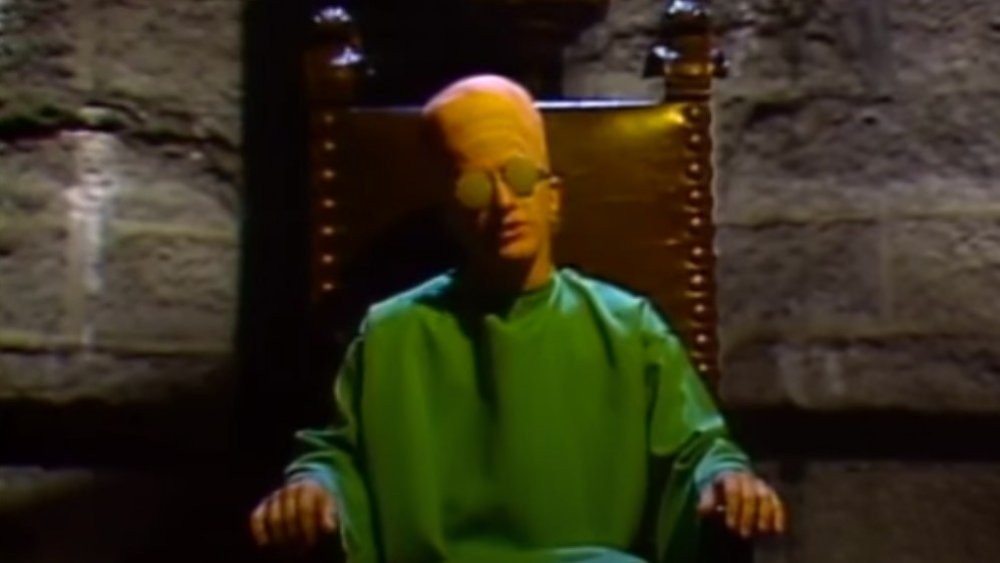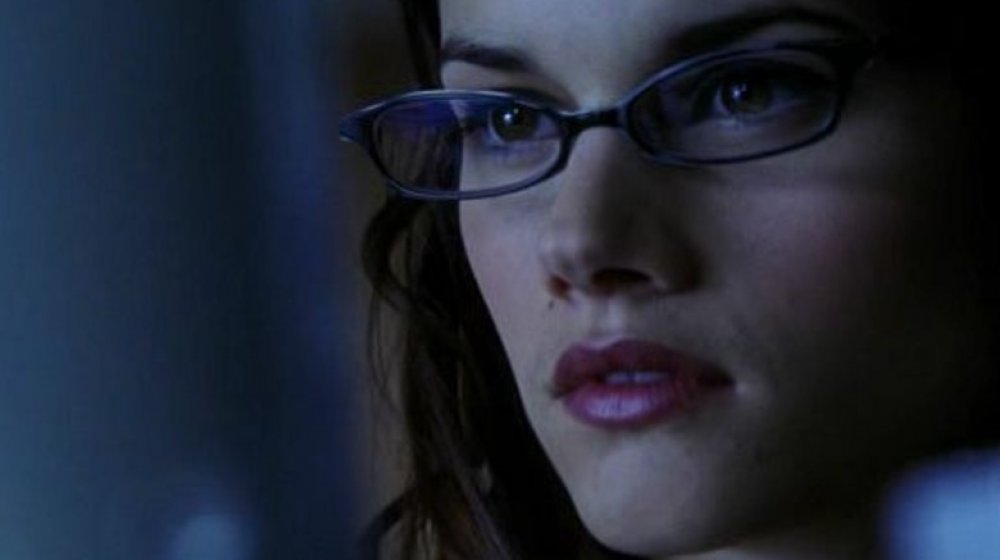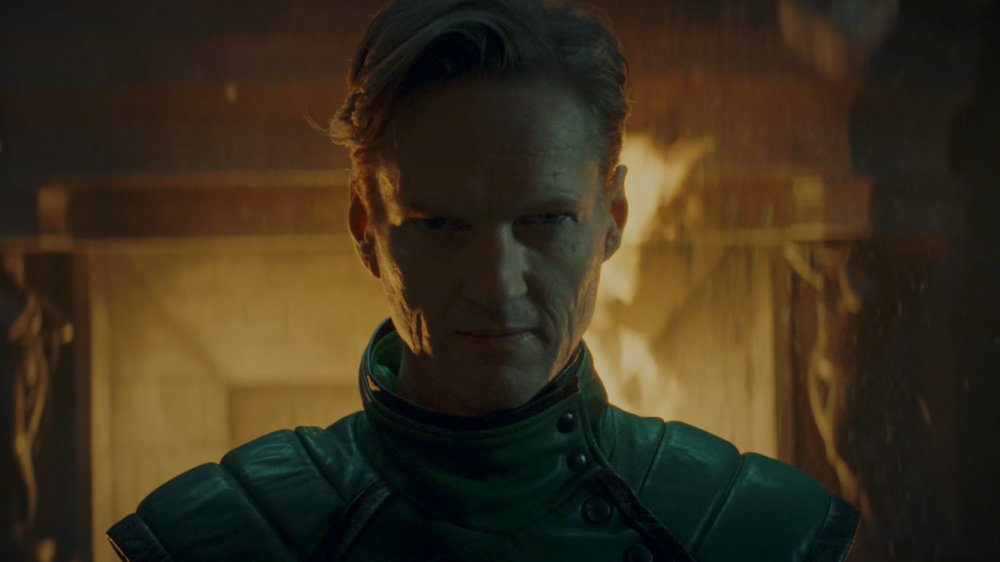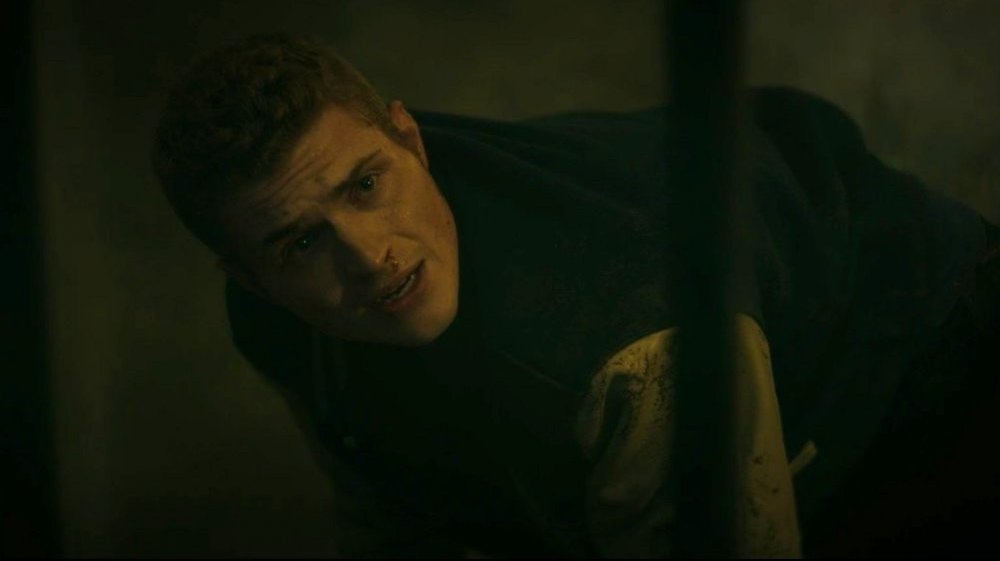The History Of DC's Brainwave Explained
Thanks to TV's Stargirl, a number of relatively obscure DC Comics villains have not only earned a new lease on life, but they've taught audiences just how seriously deadly they can be in spite of their often silly nicknames. One of those characters is Brainwave, a bad guy with powerful psychic abilities who's been a thorn in the side of DC's heroes for the better part of a century.
First appearing in the Golden Age of Comics — when superheroes reigned supreme during World War II — Brainwave is most closely associated with the Justice Society of America (JSA). He first takes on the JSA all on his own and later finds allies who've likewise been humbled by the superhero team. The character's been reinvented in interesting ways over the years, including as a gender-bent villain in one of Warner Brothers' most successful TV shows inspired by DC's comics.
From his days locking horns with the JSA to his time battling Stargirl in Blue Valley, here's the history of DC's villain Brainwave explained.
The origin of Brainwave
Henry King has an interesting origin as far as his powers are concerned. In his first appearance in 1943's All-Star Comics #15, there's no physical outward force that gives him psychic abilities. He doesn't fall into a vat of toxic waste or get bitten by any weird animals. Henry King is a lonely boy who dreams of adventure and glory. One day — as a vision of the legendary knight Lancelot appears before him — the young outcast learns he has the ability to mentally project illusions. As King grows, he learns to use his illusions to do just more than entertain himself on lazy summer afternoons.
Readers don't know any of this when they open All-Star Comics #15. Instead, we see Wonder Woman arriving at a scheduled meeting of the JSA, but instead of meeting her teammates, she finds a stack of apology letters. Each letter is written by a different JSA member, and each one describes why the hero couldn't show up. For example, Hawkman is hunting invisible murderers, while Johnny Thunder is dealing with a museum where the art comes alive. Wonder Woman eventually figures out that all of the heroes are dealing with different schemes all coordinated by the same bad guy — Brainwave.
Not long after Wonder Woman figures out what's going on, Brainwave is defeated and believed killed. A couple of issue later, however, we find him alive and well. .
Brainwave joins up with the Injustice Society
In one of his earliest returns to battle the JSA, Brainwave helps found the Injustice Society of the World (ISW), a group made up completely of villains who'd faced members of the JSA in the past, either individually or as a team. It's the Wizard who forms the team, and he and Brainwave are joined by the Gambler, Vandal Savage, Per Degaton, and the Thinker. Fortunately for the heroes, it's Brainwave's error that leads to the ISW's defeat.
Key to the ISW's plans are huge jailbreaks from five different prisons and the recruitment of the released inmates. Each supervillain in the ISW has at his command a small army of the convicts to help him deal with the JSA, and different members of the ISW are tasked with capturing different JSA members. Brainwave is tasked with bringing in Green Lantern (the original Alan Scott version), and their confrontation ends with Green Lantern falling off a cliff, which Brainwave assumes has killed the hero.
The ISW then hosts a mock trial for the JSA with the Thinker as judge. To everyone's surprise, Thinker proclaims the JSA innocent and then reveals himself to not be the Thinker. We learn Green Lantern survived his fall with the help of his magical ring and took the Thinker's place as judge. Green Lantern frees his friends, and together, they make short work of the ISW.
Brainwave gets revenge on the JSA
The Golden Age of Comics wouldn't mean the end of Brainwave. After years in solitary confinement, the brainy bad guy returns for revenge on the JSA in 1976's All-Star Comics #59, but things have changed. Somehow, the villain who was once known for his abnormally large head and relatively small and frail body is sporting the physique of a younger, muscular man. However, his youthful new look is marred by round, bulging eyes.
With the help of his old ISW colleague Per Degaton, Brainwave sets off disasters all over the globe, which the JSA is forced to split up to tackle. The scheme proves to be Brainwave's most destructive to date, with the villain eventually managing to set the Earth on a collision course with the Sun. Luckily, this adventure also marks the JSA's first meeting with the superhero Power Girl. After the team locates Brainwave's satellite, Power Girl pushes it closer and closer to the Sun, eventually causing Brainwave to fall unconscious and shorting out all of its equipment. As Brainwave succumbs to the Sun's heat, it's revealed that his new youthful body was an illusion, and the more familiar, big-headed form of Henry King appears.
Brainwave and the Secret Society of Super Villains
In DC's expansive continuity, we learn that the Justice Society of America — along with Brainwave and the ISW — are part of what's known as Earth-2. On Earth-1, we find more recognizable heroes in the Justice League of America. But the JSA and Justice League know about one another, and they occasionally visit one another and share adventures. But in a story beginning with 1981's Justice League of America #195, villains from both worlds unite to make the Secret Society of Super Villains, including the psychic Brainwave.
It's the simian villain Ultra-Humanite who forms the Secret Society, and Brainwave is his emissary to Earth-1. In an early scene, Brainwave gathers the Earth-1 villains, eventually knocking out Signalman with his powers when the rogue gets too mouthy for his own good. When the Society launches its attacks on the different heroes, Brainwave is sent after Johnny Thunder, and he successfully captures the hero while he's trying on a suit.
As is often the case, it's the villains' own, well, villainy that leads to their defeat. Upon recruiting the Earth-1 bad guys, Ultra-Humanite claims he has a plan that will wipe out all of the heroes on either Earth-1 or Earth-2, though claims he doesn't know which. It turns out he knows the whole time it will be his world, Earth-2, that will benefit, and when they learn this, the Earth-1 bad guys turn on him. The combined forces of the JSA and Justice League then escape and take down all the bad guys, imprisoning them in Limbo.
Meet Brainwave Jr.
In spite of being a man who seemed attractive neither on the outside or inside, we learn Brainwave has a son with the hero Gimmick Girl. Henry King Jr., aka the hero dubbed Brainwave, Jr. — though he prefers simply "Brainwave" — boasts abilities similar to his father's. Unlike his father, Brainwave Jr. prefers a more heroic career, although outside influences would eventually make it appear he was more like his father than he realized.
Brainwave Jr. shows up for the first time in 1983's All-Star Squadron #24 as a traveler from the future, that future being 1983, since All-Star Squadron is set in the '40s. Brainwave initially gets into a fight with the hero Tarantula, until realizing he's the exact hero the young psychic is looking for. Tarantula is convinced of Brainwave Jr.'s sincerity — in part because the young hero knows about the book Tarantula is only just working on — and listens as the man from the future warns him of an approaching danger.
Brainwave Jr. would make a name for himself as a more active hero in the pages of Infinity, Inc. However, he would later go down darker paths, though events would lead some to believe he wasn't in control of himself. When Brainwave Jr. agrees to help Black Adam liberate his homeland, the hero Atom enters the psychic's skull in hopes of shutting down his mental abilities. While there, he discovers the Shazam villain Mister Mind inside Brainwave Jr.'s head, manipulating his actions.
Brainwave's tragic sacrifice
Henry King Sr. — the original Brainwave — dies in 1985's Infinity, Inc. #10. Not only has his passing remained one of the more definitive deaths in superhero comics, but it comes about in a much more heroic manner than anyone imagined.
Wanting revenge on the members of Infinity, Inc., Ultra-Humanite — Brainwave's old ally in the Secret Society of Super Villains — hatches a plan that includes manipulating the JSA into attacking Infinity, Inc. Once again, Ultra-Humanite almost succeeds, but his biggest mistake is in trying to kill Brainwave Jr. The original Brainwave intervenes, and his involvement is the key to Ultra-Humanite's defeat.
Brainwave doesn't survive his battle with Ultra-Humanite, who mortally wounds the psychic. Before his passing, Brainwave transfers all of his powers to his son, boosting the hero's abilities significantly. It's a sad scene that would find something of an ironic and dark reflection once Brainwave found a home in television.
Brainwave's first live-action TV appearance was pretty strange
Brainwave's appearance on the first season of Stargirl in 2020 is without a doubt his most significant live-action television appearance to date. But it's not the character's first live-action appearance. In 1988, CBS aired Superman 50th Anniversary. Hosted by Dana Carvey, who was still a Saturday Night Live regular at the time, the special is something of a faux documentary that includes clips from various Superman films and television shows, short "interviews" with Superman admirers and professional henchmen, and yes, the first live-action appearance of Brainwave.
Robert Smigel plays Brainwave in his brief appearance in the special. Ironically, while it's done largely for a laugh, the character appears physically more comic book accurate than in any subsequent appearance. After a group of thugs dishes about masterminds, the camera cuts to a dungeon somewhere in Metropolis, where Brainwave sits on a large, throne-like chair, and — as we can hear water dripping in the background — says he doesn't see why the presence of Superman should make him want to leave town. He also says he thinks other evil geniuses are too impatient, saying, "They want to take over the world, and they want it Friday." Brainwave argues "it's very important to start slow." He advises other masterminds, "Take over your neighbor, your wife. I mean, some of these guys want to take over the world, and they can't even control their own kids."
Smallville's Brainwave is quite different from the comic book bad guy
Like other good and bad guys of DC's mythos, Brainwave makes an appearance on Smallville, the retrospective series about Clark Kent's life before becoming Superman. However, the Brainwave of Smallville has little in common with the source material. They have different names, different powers, and even different genders.
Early in the season 3 Smallville episode "Delete," Chloe (Allison Mack) is almost run over by a pick up truck, which we soon learn was driven by Clark (Tom Welling), though the young hero doesn't remember anything of the event. His only clue is a locked email he receives from "brainwave@instamail.org." The next day, Lana Lang (Kristin Kreuk) goes after Chloe in Smallville High, going so far as attacking her with an axe. Like Clark, she has no memory of the melee, and Clark discovers she received an email from the same address.
We soon learn Chloe's real enemy is Molly Griggs (Missy Peregrym), a former patient at the Summerholt Neurological Institute who can force people to do her will through electronic devices. She hopes to kill Chloe because of a tell-all story she wrote for the Daily Planet about Summerholt. Griggs sees Summerholt's Dr. Garner (Martin Cummins) as her savior, and she'll do anything to save him from scandal if she can.
After Clark and Lex (Michael Rosenbaum) stop her plans, Griggs disappears, and she isn't seen on the series again.
The Brainwave of Stargirl is the most menacing version of the character
Brainwave has arguably never been depicted as a more powerful or formidable a foe than he is in the first season of Stargirl. Played by Christopher James Baker, Brainwave is the key to the plan that Icicle (Neil Jackson) has set in motion to change America forever.
Like the Brainwave of the comics, this Brainwave is Henry King Sr. Along with telepathy, Brainwave boasts potent telekinetic abilities. After his showdown with Stargirl (Brec Bassinger) and S.T.R.I.P.E. puts him in a coma, his son discovers his father's powers, as well as the origins of those abilities and his motivations for becoming a villain. Henry Jr. (Jake Austin Walker) discovers his father's old videotaped journals, where Henry Sr. speaks of the experiments he conducted that gave him powers and how being able to hear other people's thoughts filled him with disgust for the rest of the human race.
The Injustice Society's plan for "Project: New America" is to amplify Brainwave's powers so he can reach out to all the minds in Nebraska and many of the surrounding states to forcibly change what people believe — a process that's expected to kill at least one quarter of those affected. When the JSA tries to stop the broadcast, Brainwave uses his powers to appear to be his son to the young hero Wildcat (Yvette Monreal). It almost works, but he makes the mistake of referring to the team as "your friends" rather than "our friends." Wildcat sees through his ruse and slashes his throat with her claws, killing him.
Things don't turn out great for Brainwave Jr. in Stargirl
When we first meet Henry King Jr. on Stargirl, he seems like little more than a bully. However, he proves to have the same powers as his father and — like his comic book counterpart — a nobler soul.
It's Henry Jr. who helps make Yolanda a social pariah at school. Along with Cindy, aka the villainous Shiv (Meg DeLacy), he manipulates Yolanda into sending him a sensitive picture, which they distribute to everyone in school. Shiv becomes Henry's girlfriend, though the relationship is forged mainly at the behest of Shiv's father, the Dragon King (Nelson Lee). As it turns out, the Dragon King correctly suspects Henry Jr. may have his father's powers and wants him kept close. After Henry Jr.'s powers to begin to emerge, it initially looks like he's going to help Shiv take down Stargirl and the rest of the JSA, but he decides to join the good guys instead.
It takes a lot of convincing, but the JSA lets Henry join them in their first infiltration of the Injustice Society's underground lair. Sadly, Henry doesn't survive. As the JSA tries to escape the lair, Brainwave is in pursuit, and Henry Jr. stops to confront his father. While Henry Jr. has his father's powers, he's still inexperienced, and Brainwave easily overcomes him. In a darkly ironic twist of how things turned out in the comics, Brainwave murders his son and absorbs his powers to boost his own abilities.
